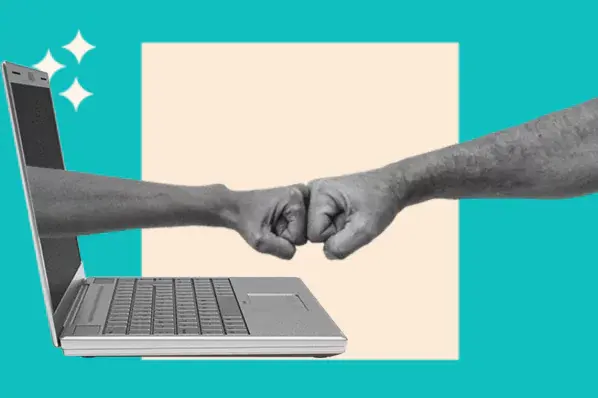“Personal branding” might sound like one of those ambiguous, done-to-death buzzwords thrown around by tech companies and influencers — but having a grip on how to develop yours can be huge when it comes to your advancing your career and gaining professional visibility.
In the age of social media, the soundness of your virtual identity can influence your ability to reach prospects where they are and enhance your internal standing at your company — so a well-constructed, actively maintained personal brand can be a major asset for any professional, especially in fields like sales or marketing.
Plus, as I found out, building your brand can actually be fun (I know how that sounds, but I'm serious.) Read on for a look at the what, how, and why of developing a personal brand — along with an overview of my ongoing, desperate, scorched-earth journey of building one of my own.
Download Now: The Complete LinkedIn Playbook [Free Guide]
Table of Contents
- What is personal branding?
- Why is personal branding important?
- 5 Personal Branding Essentials
- Personal Branding Strategy
- Personal Branding Examples
- How I Built My Personal Brand
- Personal Branding Resources
What is personal branding?
Your personal brand is the external-facing, (mostly) online representation of your personality, skill set, and experience — a way to convey your identity in the age of social media.
Developing a strong, prominent personal brand is an excellent way to get more eyes on your work, draw attention to your company as a whole, distinguish yourself from others in your space, and establish yourself as an esteemed thought leader at the forefront of your industry — but for all of its benefits, putting that kind of online presence together isn't all roses.
In fact, it can really suck.
Crafting and projecting a distinct online persona can be nerve-racking, frustrating, awkward, and embarrassing at points — especially if you're a bit more introverted than most.
Want to know how I know that? Well, I‘m in the process of developing my personal brand via LinkedIn right now, and getting there sure as heck has its gosh-darn ups and downs. We’ll dig into that a bit more later.
Anyway, a personal brand is exactly that: personal. It‘s a chance for you to project your individuality in a professional context — the sum of all of the public-facing content you’ve either posted or presented publically, so the more personal content you push out, the more opportunity you have to guide the narrative around who you are to the world.
So why, exactly, is that worth the effort?

Free LinkedIn Profile Guide
A complete guide to optimizing your LinkedIn profile, creating top-tier content, and implementing networking strategies.
- Writing compelling headlines and summaries
- Developing your own content strategy
- Harnessing the power of LinkedIn messaging
- And More!
Download Free
All fields are required.

Why is personal branding important?
I just said this like 30 seconds ago, but I‘ll say it again: Personal branding can really suck. I didn’t want to commit to developing my personal brand at first, but after some careful consideration and pressure from management, I started to see the value of it.
Here are some of the key selling points that sold me on the concept.
You can differentiate yourself from competitors.
Honestly, my professional space — sales-related and sales-adjacent content curation — might not be as tight or cutthroat as your sales vertical. Still, I wanted to establish myself as the big dog in the B2B blog editor community. Developing a personal brand was one of the better ways to get there.
It offered me a chance to flex my personality and establish myself as a unique voice among the notoriously merciless cesspool of chaos and competition that is the broader content writing community.
That need to stand out might even be more crucial in sales. It's an inherently self-driven practice, so standing out from your competition is key — developing and maintaining a personal brand can be a big asset to helping you get there.
You can set yourself up to start and promote your own business.
Entrepreneurship is extremely brand-driven. Startups need to differentiate themselves as they get their feet set — so if you have entrepreneurial aspirations, developing a strong personal brand can help smooth that process.
If you develop your personal brand effectively, you can set things in motion with a differentiating presence behind you. You'll also acquaint yourself with the brand-building process — that experience can be extremely valuable, down the line.
You can increase your authenticity and, ultimately, sell more.
According to sales expert and author Jill Konrath, the rep is the primary differentiator in sales today. No matter what they're buying, prospects know they can get a similar product or service from another vendor.
What they can't get from just any provider is the same sales experience with the same salesperson. And since consumers are twice as likely to say user-generated content is more authentic than brand-created content, they‘re looking for people who create content that’s representative of a person, rather than a company.
By presenting a distinct personal brand, you'll make it easier for your buyers to choose your company (and you) over another vendor.
5 Personal Branding Essentials
So you've set aside some time to work on personal branding. Where to start? Here are the five essential components of an effective personal brand.
1. A Complete LinkedIn Profile
LinkedIn is generally the center of your personal brand — especially if you‘re trying to make a name for yourself in a space like sales or marketing. Your target audience will research you on the network before deciding to work with, hire, or refer you. So it’s crucial to fill out your profile and make it compelling.
Pressed for time? Address these key areas before anything else:
- Choose your picture deliberately. A high-quality, professional picture is a must-have. Depending on how you're trying to differentiate yourself, choose a picture that shows you in a certain light. Seeking a training gig? Post a picture of you speaking or teaching others. Attempting to attract buyers in a buttoned-up industry? A suit, tie, and direct, confident gaze will do the trick. Your profile photo is the first glance people have of your personal brand, so make sure it gives the right appearance.
- Optimize your headline. Don't just list your title and company. Consider using your positioning statement as your headline or trying out these headline tips from job search expert, Jenny Foss.
- Enhance your summary. Your LinkedIn summary offers you the most reliable opportunity to flex your personality for everyone who stumbles across your profile. It's a staple of your personal brand, so you need to craft one that has a compelling hook and some concise perspective on who you are — all backed by a distinct voice.
- Feature visual content. Whether you create content or curate it, you should include eye-catching visual content in your gallery that will interest your target audience. Select pieces that reinforce the vision set out in your positioning statement. For example, if you are a firm believer in the power of recruiting technology to source high-quality candidates, post a SlideShare or infographic on the topic.
If you need a full profile makeover, check out this guide to optimizing your LinkedIn page.
2. A positioning statement.
If you‘re in sales, you’re no stranger to positioning statements. Smart reps always have a succinct statement on hand about their product or service to combat the inevitable “What is this about, anyway?” buyer brush-off. A personal positioning statement should answer the slightly amended question “What are you about, anyway?”
When crafting a personal positioning statement, keep your target audience in mind. Your value proposition might be about you but it's not for you. Express to your target audience what makes you different from others in your industry, profession, or role. If you're not sure what makes you different, spend some time researching your peers and reflecting on your individual beliefs and passions.
Consider these LinkedIn personal branding statement examples from influential leaders:
Sara Blakely: Founder of SPANX, who has nearly 1.6 million followers.
I am the founder and CEO of SPANX! I started SPANX in 2000 with $5,000 in personal savings and I’ve never taken any outside investments. I am a big believer in following your instincts and taking unique approaches to business.
Richard Branson: Founder of Virgin Group, who has over 19 million followers.
Founder of the Virgin Group, which has gone on to grow successful businesses in sectors including mobile telephony, travel and transportation, financial services, leisure and entertainment, and health and wellness. I'm a tie-loathing adventurer, philanthropist, and troublemaker, who believes in turning ideas into reality. Otherwise known as Dr Yes!
In terms of format and structure, stick to these guidelines:
- Shorter is better. A few concise sentences are ideal.
- Instead of using nouns to explain what you do (title at company), use verbs to illustrate how you do it.
- Avoid overused words such as “motivated,” “strategic,” and “driven.”
- Avoid industry jargon and acronyms.
3. An SEO-friendly profile.
Equally important as defining and capturing what makes you different is ensuring that you can be easily found online. After all, there's not much point in writing a positioning statement if no one reads it.
For this reason, cursory keyword research is an essential part of any personal branding initiative. Again, instead of thinking about the keywords you most associate with yourself, think about the words or phrases your target audience might search for to find someone like you. Keyword phrases could be industry-related (“human resources”), role-related (“talent acquisition manager”), or results-related (“cut hiring costs”). If you're struggling to think of keywords, check out the free app Keyword Tool.io for inspiration.
Once you‘ve decided on a keyword or two, insert them into your LinkedIn profile, Twitter bio, blog, resume, website, and any other online or social media spaces you’re involved in. Just make sure to do so naturally. Inserting a nonsensical sentence chock full of keywords onto a web page is called keyword stuffing and will send you to the bottom of Google in a hurry. A good rule of thumb is to include your keyword in your LinkedIn header and two to three times in the “About” section.
4. A unique point of view.
What you say and how you say it defines your personal brand. If you sound and look just like everyone else, your branding won‘t stand out—and it definitely won’t be memorable. That‘s why it’s crucial to develop a voice that sounds like you and shares your unique opinions.
To understand what point of view you have to offer, ask yourself the following questions:
- How would I describe myself in 3-5 words?
- Is my tone formal or casual?
- Do I use certain words or avoid certain words (ie. swear words or industry jargon)?
- What do I do better than anyone else?
- What value can I offer to my community/industry/network?
To help, you can try honing in on your personal brand with our free persona tool.
When you know what sets you apart, you'll be able to create posts and articles that share your point of view and build your personal brand.
5. A consistent posting schedule.
Once your profile is optimized and your point of view defined, it's time to start posting.
One of the best ways to explain how your approach differs from your peers‘ is to write it down for all to see. Use LinkedIn status updates to share your thoughts on an industry or workplace trend, or write an article about a new product you’re selling, your most helpful sales tactics, or how you got started in your industry.
While your posts shouldn't be blatant self-advertisement, you can use your LinkedIn as a personal branding vehicle by taking the right angle. Make sure each post adds to the larger conversation while differentiating your point of view from others.
Here are a few article examples:
- Everyone‘s Saying X about Trend Y. Here’s Why I Disagree
- Y Mistakes Most Professionals Make When Doing Z
- The Unique Way I'm Planning to Address X at My Organization
First-time writer? No problem. Check out these free HubSpot blog post templates to get off on the right foot.
While it‘s important to share your thoughts through posts and articles, it’s also essential to be consistent. Posting three times per week for a month, and then stopping for two months, hurts your credibility and growth. It's better to develop a habit you can maintain, like posting twice per month, than pushing out a mass amount of content before going cold for a long period of time.
Figure out a posting schedule that works for you, and stick to it.
Personal Branding Strategy
Your personal branding strategy will ultimately be specific to you — hence the term personal — but there are some key strategic elements you‘ll want to consider when putting yours together. Here’s a quick look at what those are.
Goals
You can‘t put together a focused, thoughtfully structured personal brand if you have no idea what you’re hoping to accomplish with it. Are you doing this for career development? Better visibility with internal leadership at your company? Brand exposure? Something else entirely?
Whatever your endgame might be, make sure you have a clear picture of it. Your ideal outcomes will be pivotal when you start developing your virtual identity.
A Theme
Effective personal brands are tonally consistent. Know how you want to be perceived and keep your content threaded accordingly. For instance, if you want to come off as a more serious, consultative resource for followers, keep things tactical and don't get too hung up on trying to be silly in your posts.
A Personal Appeal
This point is kind of similar to the previous one. You want your personal brand to be distinct — again, personal is the operative word in the term personal branding. You need to identify the ways you can distinguish yourself from others in your space.
Cliche as this sounds, understand what makes you you. Find the specific qualities that set your personality and professional identity apart. Once you've pinned those down, lean into them as much as possible.
Now that you have a sense of what goes into a personal brand, let's take a closer look at what those elements can look like in practice.
Personal Branding Examples
Need some personal branding inspiration? Look no further than the following professionals.
1. Katie Burke
Katie, former Chief People Officer of HubSpot, is incredibly active on LinkedIn. Not only does she share her own content, like when she‘s invited to speak at industry webinars, but she also consistently engages with HubSpot employees and customers. By sharing other people’s posts and celebrating their wins, she reinforces her role as a leader and builds her personal brand.

2. Liz Ryan
With nearly 3M followers on LinkedIn, Liz built a personal brand around providing helpful HR advice to job seekers and leaders. Her posts focus on advising her audience and gathering insights, which draws people looking for career advice or a coach — and to her books and business. But even if you don't buy, she still provides extremely valuable advice to her followers.

3. Cristina Mittermeier
Cristina is a marine biologist, photographer, and the founder of the ocean conservation organization SeaLegacy. Her personal brand highlights her abilities as a scientist and educates people on conservation through visual storytelling. She shares relevant articles, podcasts, images, and campaigns that interest her followers to raise awareness for the various causes she supports.

How I Built My Personal Brand
Let me start by offering a link to my LinkedIn profile, in case you're curious about how all of this has come together.
Okay, now that that's out of the way, we can lock in.
I‘m going to preface this by saying I’m relatively new to personal branding. I‘m not the guy on LinkedIn with millions of followers, plugging my most recent TEDx talk — so I think it would be more appropriate to entitle this section "How I’m Building My Personal Brand."
Still, I like to think I‘m doing a pretty solid job so far. Here’s how I've been going about it.
1. I swallowed my pride.
Admittedly, I really didn‘t want to develop a personal brand at first, especially via LinkedIn. I have a lot of respect for LinkedIn influencers, but I’m pretty reserved when it comes to my online presence (I have maybe 150 Instagram followers.)
It honestly took a push from management on HubSpot's Media Team — who told me they liked my zany, delightfully kaleidoscopic personality so much that I was required to share it via LinkedIn — for me to even consider developing a personal brand.
I resented it initially, as you might be able to tell from my first post:

Ultimately, I‘m glad they made that push. Building my brand has been a surprisingly good time, and it’s gotten me some valuable exposure and professional traction — but figuring out how to approach the process was, well, a process.
2. I settled on a voice.
When I started on my relentless, scorched-earth personal branding journey, I was kind of lost. I didn't really have a sense of the kind of content I should be posting nor the best tone to back it with.
I had seen a lot of LinkedInfluencers post short-form videos and discuss professional lessons they pulled from non-professional experiences, so I figured I might start there — but after giving it some thought, I realized that those strategies probably weren't going to work for me.
My camera presence is kind of trash — as you can see from this godforsaken TikTok I made where I explain why salespeople should never say the phrase “Trust me” — and I generally try to keep my non-professional life as non-professional as possible.
So yeah, I was pretty lost.
One day, I was tasked with updating a post about LinkedIn summaries that required me to post a screenshot of mine. I didn‘t have one at the time, so I put one together that covered some key bases that were referenced in the article — here’s what it looked like:

I showed it to some people, and they liked the tone. Later that day, I was eating lunch with some co-workers, and I mentioned that I was frustrated with the new "Be LinkedInfluential" aspect of my job description.
One of my colleagues joked that I should pick random activities and say what they taught me about sales like, “I just ate a rotisserie chicken — here's what that taught me about objection-handling.”
I never made that post, but I liked that concept of “anti-influencing,” so I just started running with it.
3. I identified the value I could add.
Your personal brand is a vessel for you to project thought leadership — but I'm kind of in a weird spot as far as that goes. I write for sales professionals, but I see myself as less of a bonafide thought leader in that space and more of a facilitator who helps sales experts articulate and spread their ideas.
The value I can offer doesn‘t really lie with me personally giving the sales audience a spiel about how to do their jobs better. Instead, I’m better suited to shed light on the thought leadership content I helped sales leaders produce — all with a distinct, engaging spin.
Here's an example of what that looks like:

With that post, I didn‘t try to say anything I wasn’t qualified to say and I understood where my experience was. I stayed in that lane, and I tried to make my content as entertaining and thoughtful as possible without straying too far from it.
4. I (try to) publish regularly.
I promise I do my best on this front. I try to push content out at least once a week. Admittedly, that sometimes falls by the wayside — but I understand how important it is. A consistent publishing schedule can be a big help when it comes to effective personal branding.
You develop a personal brand by establishing expectations and constantly delivering on them — that's why having some sort of editorial cadence for your content can keep you top-of-mind with your current and potential followers.
Again, this is an area where I have some room for improvement. I often get too caught up with other responsibilities to buckle down and push my more “me-specific” content out. Still, I can recognize that this is something I need to work on, and I'm going to try to push more content out, going forward.
5. I kept at it.
It might be more appropriate to say “I'm keeping at it.”
As I said, I‘m still pretty green when it comes to personal branding, so it’s a little early for me to be patting myself on the back and reflecting on how I built my personal brand like it‘s something I’ve been doing for years. Still, I‘m persisting — even when the posts I make don’t really hit.
For instance, I was pretty bummed out when this post didn't get the traction I wanted it to:

I was kind of embarrassed that I put an inordinate amount of time and effort into that graphic … only to put it on the Internet only to get 36 likes — but such is life for us LinkedInfluencers. You hit walls sometimes, but you have to keep your feet moving.
I have a ways to go before I can really say that I‘ve developed a robust, totally productive personal brand — but I like to think I’m on my way. I hope that my approach is fresh and engaging enough to have a lasting impact with my target audience, and I think I can make at least some headway if I keep publishing consistently.
Personal Branding Resources
Creating a strong personal brand requires getting to know yourself and putting in the work to create consistent, unique content. These free personal branding resources can help you get started, with templates for writing a professional bio, defining goals, and so much more.
Developing a personal brand is a tricky process — one that involves a lot of effort, persistence, and growing pains. Still, if you can identify and project a distinct voice that adds legitimate value for your target audience, you can at least start to get yours off the ground.
And who knows, maybe one day your brand will be recognizable, memorable, and unique enough for a stranger to say, “Oh, I've heard of you. You're the [insert what sets you apart] person.”
Editor's note: This post was originally published in June 2015 and has been updated for comprehensiveness.

Free LinkedIn Profile Guide
A complete guide to optimizing your LinkedIn profile, creating top-tier content, and implementing networking strategies.
- Writing compelling headlines and summaries
- Developing your own content strategy
- Harnessing the power of LinkedIn messaging
- And More!
Download Free
All fields are required.












